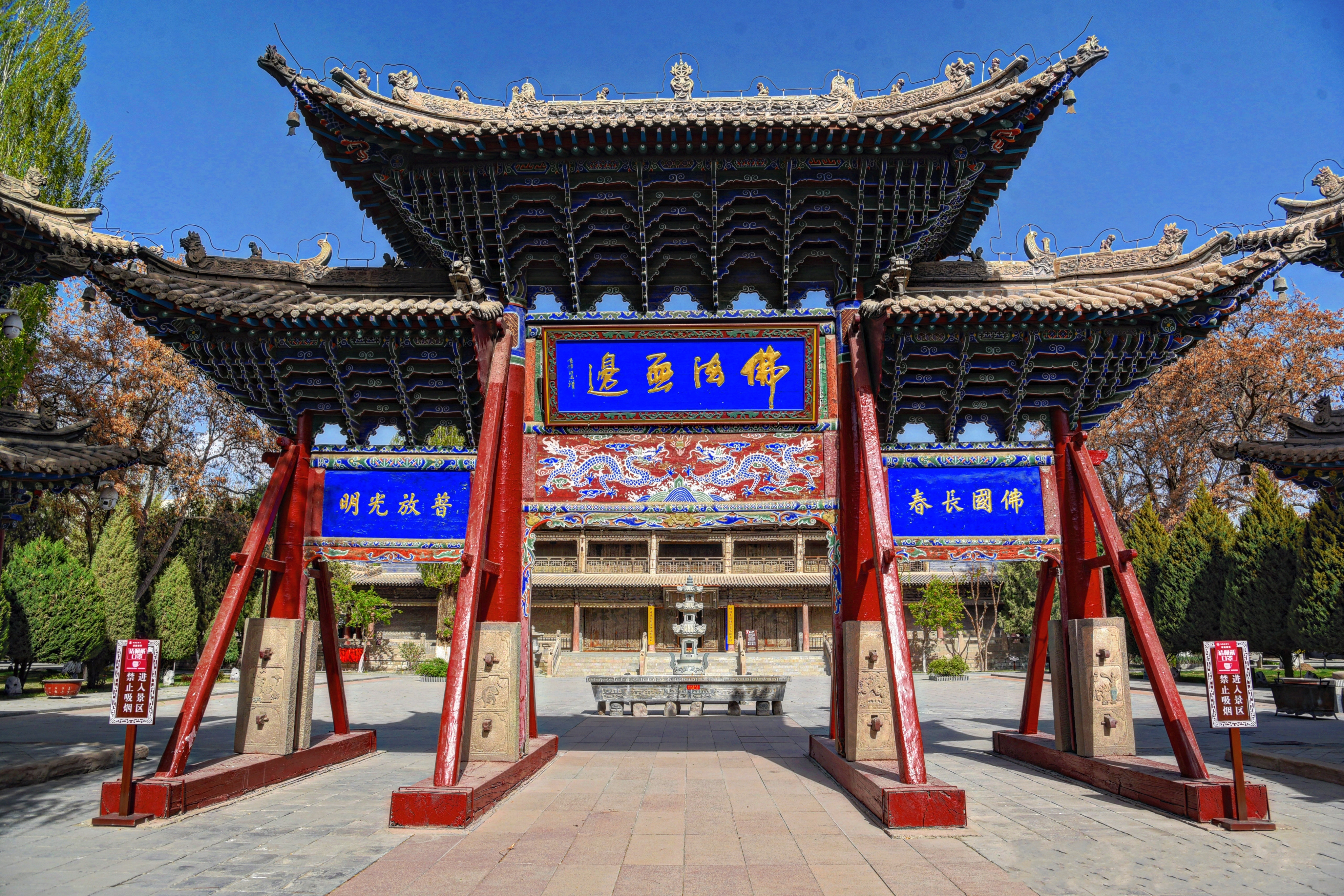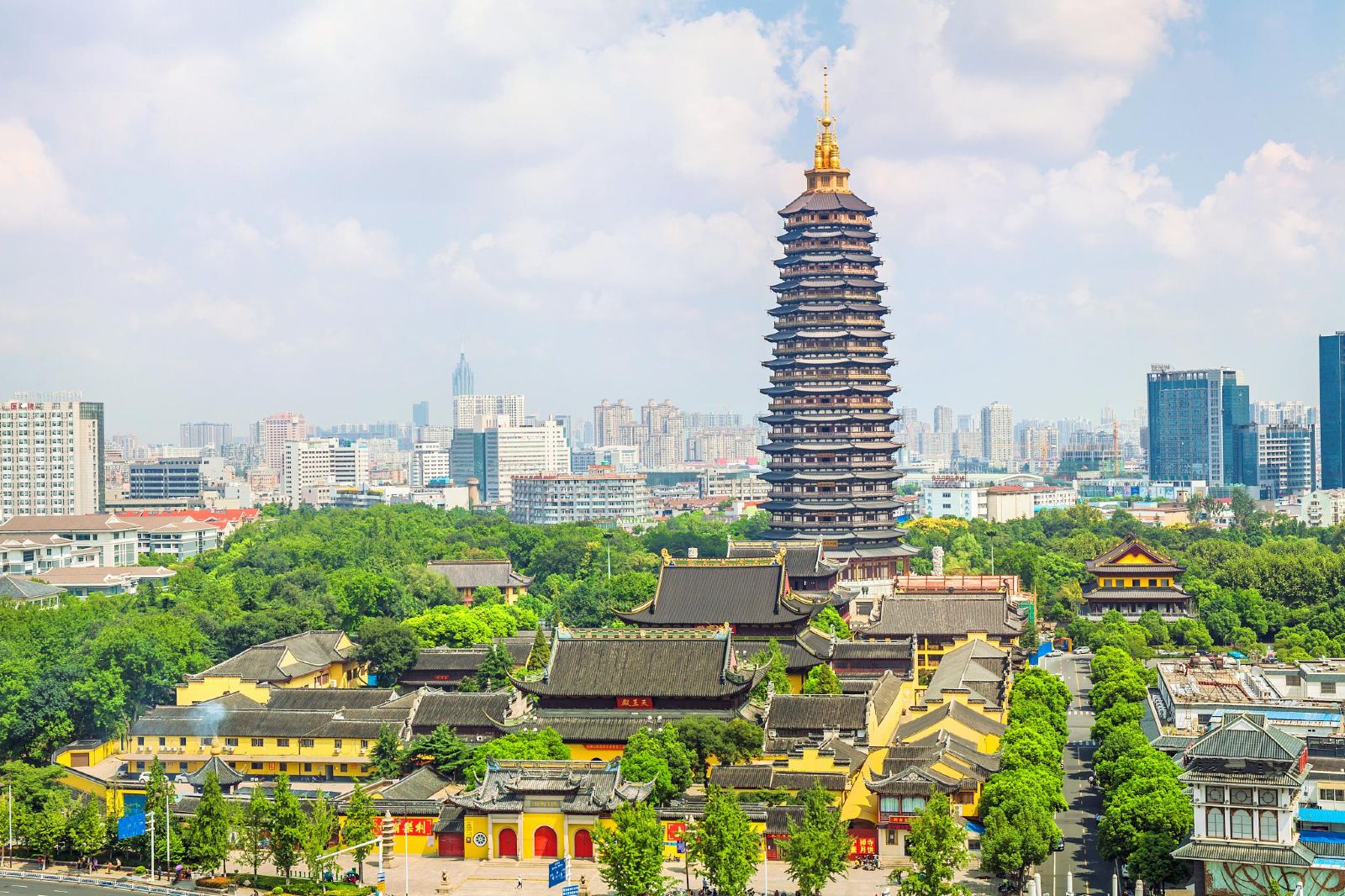
Deutsch-Chinesische Enzyklopädie, 德汉百科


Der Tempel des Großen Buddha in Zhangye (chinesisch 张掖大佛寺, Pinyin Zhāngyè Dàfó sì) ist ein buddhistischer Tempel im Südwesten von Zhangye in der chinesischen Provinz Gansu. Er wurde 1098 erbaut und stammt aus der Zeit der Xixia (Westliche Xia). Er hieß ursprünglich Kashyapa-Tathagata-Tempel (Jiāyè Rúlái sì 迦叶如来寺) und wird auch Tempel des Schlafenden Buddha (Wòfó Sì 卧佛寺) genannt. In dem Tempel befindet sich der größte liegende Buddha Chinas.
张掖大佛寺,原名迦叶如来寺,因寺内供奉释迦牟尼涅槃像,又名“卧佛寺”,为历代皇室敕建的寺院,是国家AAAA级旅游景区。位于甘肃省张掖市甘州区民主西街大佛寺巷,总面积三万余平方米。始建于西夏崇宗永安元年(1098年)。
张掖大佛寺景区是丝绸之路上的一处重要名胜古迹群,也是历史文化名城金张掖的标志性建筑。 这里保存有全国最大的西夏佛教殿堂——大佛殿、最大的室内木胎泥塑卧佛和最完整的初刻初印本《永乐北藏》,是集建筑、雕塑、壁画、雕刻、经籍和文物为一体的佛教艺术博物馆。

滕王阁,江南三大名楼之一。位于中国江西省南昌市赣江畔。屡毁屡建,今日之滕王阁为1989年重建。
Der Tengwangge-Pavillon befindet sich im Norden der Stadt, am Zusammenfluss vom Ganjiang und Fuhe. Der Bau des Pavillons wurde während der Tang-Dynastie im Jahre 653 von Prinz Li Yuanying in Auftrag gegeben. Über viele Jahrhunderte hinweg galt das Gebäude als der Höhepunkt der Pavillon-Architektur in China. Vom 9-stöckigen, mehr als 57 Meter hohen Pavillon hat man eine perfekte Aussicht auf die Stadt Nanchang und die beiden Ströme Ganjiang und Fuhe. In den vergangenen fast anderthalb Jahrtausenden wurde das Gebäude mehr als 20 Mal in Folge durch Kriege oder Unwetter zerstört und ist immer wieder neu errichtet und ausgebaut worden. Die letzte Renovierung war vor 13 Jahren. Vor Jahrhunderten war der Pavillon ein häufiger Treffpunkt für Fürsten, Mandarine und auch Literaten. Besonders in der Abenddämmerung im Herbst bietet sich den Besuchern des Pavillons ein idyllisches Bild. Ein Dichter aus der Tang-Dynastie namens Wang Bo schilderte einmal die Szenerie, die ihn bezauberte: "In der Herbstabenddämmerung wirft man einen Blick aus der Höhe des Gebäudes hinaus in die Ferne, und es lässt sich kaum erahnen, wo der Horizont den Fluss vom Himmel scheidet. Erst die Wildenten, die dort in der Ferne himmelwärts ziehen, lösen das Bild auf".
Diese poetische Beschreibung von Wang Bo wurde berühmt und hat auch den Tengwangge-Pavillon bekannt gemacht. Der Pavillon zieht seither alle an, die auf den Spuren des Dichters jene Szenerie nachempfinden wollen, die ihn so tief beeindruckt hatte.(Quelle: www.chinareisedienst.de)
唐代の653年(永徽四年)、当時この地に封じられた李元嬰(唐の建国者・李淵の第22子)の道楽によって建てられた。彼は最初は滕県(現在の山東省滕州市)に封じられていたため滕王と呼ばれており、ここから滕王閣と呼ばれる。幾度も戦乱などにより破壊された。清の同治年間に28回目の再建が行われたが1929年に軍閥同士の戦争で破壊され再建されていなかった。現在のものは1989年に再建されたもので29回目の再建に当たる。
贛江のほとりに建てられており、楼閣から街を見下ろすことができる。
The Pavilion of Prince Teng (Chinese: 滕王阁; pinyin: Téngwáng gé) is a building in the north west of the city of Nanchang, in Jiangxi province, China, on the east bank of the Gan River and is one of the Three Great Towers of southern China. The other two are the Yueyang Tower and the Yellow Crane Pavilion. It has been destroyed and rebuilt many times over its history. The present building was rebuilt in 1989 on the original site. The rebuilding plan was devised by the architect Liang Sicheng, and now the Pavilion of Prince Teng is the landmark of Nanchang. There are nine floors in total. The main architectural structure is in Song dynasty wooden style, showing the magnificence of the Pavilion.
The Pavilion of Prince Teng was first built in 653 AD, by Li Yuanying, the younger brother of Emperor Taizong of Tang and uncle of Emperor Gaozong of Tang. Li Yuanying was enfeoffed as Prince Teng in 639 and spent his early years in Suzhou. In 652 he was assigned the governorship of Nanchang where the pavilion served as his townhouse. The Pavilion of Prince Teng is the only existing royal architecture in southern China. Twenty years later, the building was rebuilt by the new governor. Upon its completion, a group of local intelligentsia gathered to compose prose and poetry about the building. The most famous of these is the Preface to the Pavilion of Prince Teng by Wang Bo. This piece made the Pavilion of Prince Teng a household name in China down to the present day.
The Pavilion was to be destroyed and rebuilt a total of 29 times over the next centuries.[1] The building itself changed shape and function many times. The penultimate construction was during the Tongzhi era of the Qing Dynasty. That building was destroyed in October 1926 during the chaotic warlords era.[2]
Le Pavillon du Prince Teng (chinois simplifié : 滕王阁 ; chinois traditionnel : 滕王閣 ; pinyin : ) se situe sur la rive est de la rivière Gan dans la ville de Nanchang dans la province de Jiangxi en Chine. L'édifice a été au fil du temps plusieurs fois détruit par des incendies puis reconstruit.
Le pavillon est bâti en 653 par Li Yuanying, frère cadet de l'empereur Tang Taizong. Li Yuanjing est intronisé Prince Teng en 639 et passe son enfance à Suzhou. Une vingtaine d'années après l'achèvement de la construction, le poète Wang Bo écrit un célèbre poème intitulé Préface au pavillon du Prince Teng.




天贶殿为宋 代修建。元称仁安殿,明称峻极殿,民国改称至今,缘于宋真宗假造“天书”之事。殿主祀泰山神东岳大帝 。殿面阔九间,进深五间,八根红色大檐柱耸立廊前,重檐九脊,黄瓦飞甍,金碧辉煌。
殿内东、西 及北墙壁上,有著名的道教壁画《泰山神启跸回銮图》,壁画高3.3米,长62米,传为宋代所作。壁画描绘了泰山神东 岳大帝出巡回銮的盛况。画面有人物691人,车水马龙,千姿百态;山水树木,殿阁桥梁,点缀其间。造型生动形象, 构图宏伟合理,堪称艺术珍品。
殿前露台高筑,汉白玉雕栏环绕,云形望柱齐列,玉阶曲回。中间置 放着明代铁铸大香炉和宋代两个大铁桶,两侧御碑亭立有乾隆谒岱庙诗碑。
东环廊现陈列历代名碑刻 19块,北侧有封禅蜡像馆,内有宋神宗等19尊蜡像,逼真生动。西环廊陈列汉画像石48块。
天贶殿是 岱庙中的主体建筑,与北京故宫太和殿、曲阜孔庙大成殿并列为中国古代三大宫殿式建筑。
Die Tian-Kuang-Halle ist das Hauptgebäude des Dai-Tempels, das zusammen mit der Halle der Höchsten Harmonie in der Verbotenen Stadt und der Halle des Dacheng im Konfuzius-Tempel in Qufu zu den drei wichtigsten Palastgebäuden des alten China zählt.






 Architecture
Architecture

 History
History
 Religion
Religion
 World Heritage
World Heritage